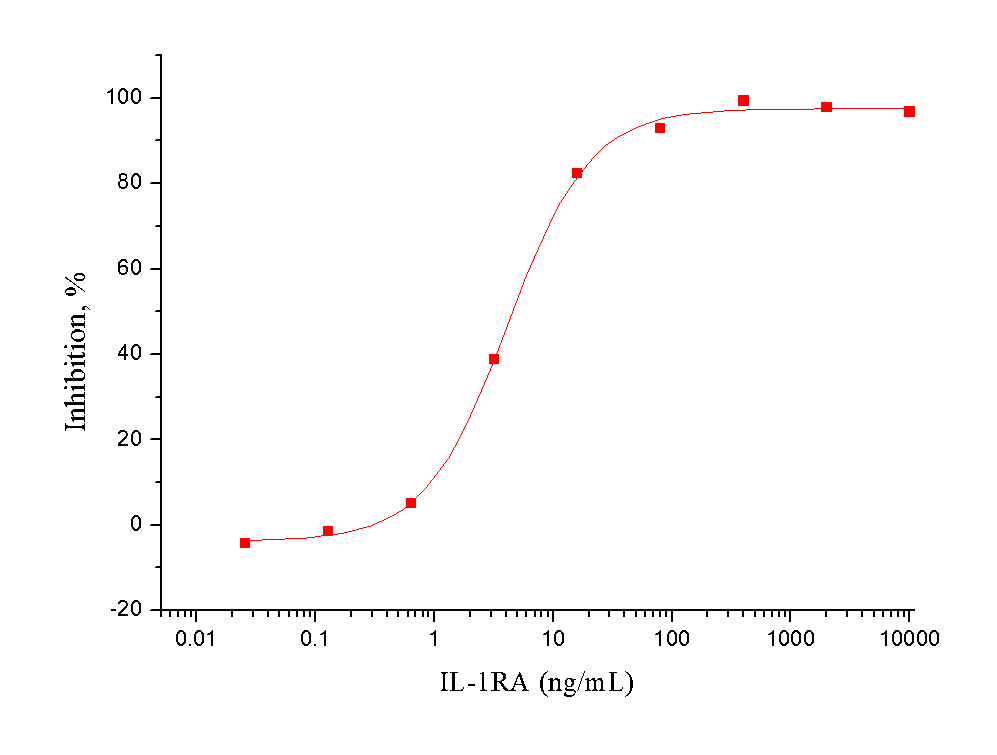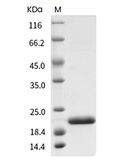Shopping Cart
Remove All Your shopping cart is currently empty
Your shopping cart is currently empty
IL-1RA Protein, Human, Recombinant is expressed in E. coli expression system. The predicted molecular weight is 17.3 kDa and the accession number is P18510-1.

| Pack Size | Price | USA Warehouse | Global Warehouse | Quantity |
|---|---|---|---|---|
| 5 μg | $33 | 7-10 days | 7-10 days | |
| 10 μg | $48 | 7-10 days | 7-10 days | |
| 20 μg | $75 | 7-10 days | 7-10 days | |
| 50 μg | $139 | 7-10 days | 7-10 days | |
| 100 μg | $233 | - | In Stock |
| Biological Activity | 1. Measured by its binding ability in a functional ELISA. Immobilized human IL1RA at 10 μg/ml (100 μl/well) can bind human IL1R2-Fc , The EC50 of human IL1R2-Fc is 0.04-0.1 μg/mL.
2. Measured by its binding ability in a functional ELISA. Immobilized human IL1RA at 10 μg/ml (100 μl/well) can bind human IL1R1-Fc , The EC50 of human IL1R1-Fc is 0.08-0.2 μg/mL.
3. Measured by its ability to induce Interferon gamma secretion by human natural killer lymphoma NK-92 cells in the presence of 250pg/mL IL1a. The EC50 for this effect is typically 3-12 ng/mL.  |
| Description | IL-1RA Protein, Human, Recombinant is expressed in E. coli expression system. The predicted molecular weight is 17.3 kDa and the accession number is P18510-1. |
| Species | Human |
| Expression System | E. coli |
| Tag | Tag Free |
| Accession Number | P18510-1 |
| Synonyms | MVCD4,IRAP,interleukin 1 receptor antagonist,IL-1RN,IL-1ra3,IL-1ra,IL1RA,IL1F3,ICIL-1RA,DIRA |
| Construction | A DNA sequence encoding the mature form of human IL1RA isoform1 (NP_776214.1) (Arg 26-Glu 177) was expressed. Predicted N terminal: Met |
| Protein Purity | ≥ 95 % as determined by SDS-PAGE  |
| Molecular Weight | 17.3 kDa (predicted); 17.3 kDa (reducing conditions) |
| Endotoxin | Please contact us for more information. |
| Formulation | Lyophilized from a solution filtered through a 0.22 μm filter, containing PBS, pH 7.4. Typically, a mixture containing 5% to 8% trehalose, mannitol, and 0.01% Tween 80 is incorporated as a protective agent before lyophilization. |
| Reconstitution | A Certificate of Analysis (CoA) containing reconstitution instructions is included with the products. Please refer to the CoA for detailed information. |
| Stability & Storage | It is recommended to store recombinant proteins at -20°C to -80°C for future use. Lyophilized powders can be stably stored for over 12 months, while liquid products can be stored for 6-12 months at -80°C. For reconstituted protein solutions, the solution can be stored at -20°C to -80°C for at least 3 months. Please avoid multiple freeze-thaw cycles and store products in aliquots. |
| Shipping | In general, Lyophilized powders are shipping with blue ice. |
| Research Background | Interleukin-1 receptor antagonist (IL-1RA) also known as IL1RN is a member of the interleukin 1 cytokine family. This protein inhibits the activities of interleukin 1, alpha (IL1A), and interleukin 1, beta (IL1B), and modulates a variety of interleukin 1 related immune and inflammatory responses. A polymorphism of this protein-encoding gene is reported to be associated with an increased risk of osteoporotic fractures and gastric cancer. IL-1RA/IL1RN may inhibit the activity of IL-1 by binding to its receptor and it has no IL-1 like activity. Genetic variation in IL-1RA/IL1RN is associated with susceptibility to microvascular complications of diabetes type 4 (MVCD4). These are pathological conditions that develop in numerous tissues and organs as a consequence of diabetes mellitus. They include diabetic retinopathy, diabetic nephropathy leading to end-stage renal disease, and diabetic neuropathy. Diabetic retinopathy remains the major cause of new-onset blindness among diabetic adults. It is characterized by vascular permeability and increased tissue ischemia and angiogenesis. Defects in IL-1RA/IL1RN are the cause of interleukin 1 receptor antagonist deficiency (DIRA) which is also known as deficiency of interleukin 1 receptor antagonist. Autoinflammatory diseases manifest inflammation without evidence of infection, high-titer autoantibodies, or autoreactive T-cells. DIRA is a rare, autosomal recessive, genetic autoinflammatory disease that results in sterile multifocal osteomyelitis, and pustulosis from birth. |
| Size | Quantity | Unit Price | Amount | Operation |
|---|

Copyright © 2015-2026 TargetMol Chemicals Inc. All Rights Reserved.